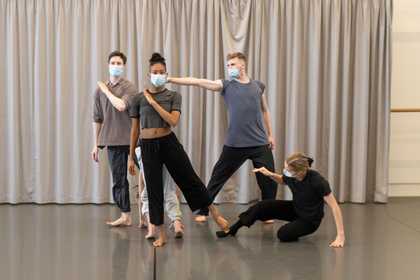Explore Trisha Brown’s unique choreography and her collaborations with artists
In 1983 Trisha Brown premiered her new dance Set and Reset at Brooklyn Academy of Music, New York, which went on to transform dance history. It signalled a shift in Brown’s practice, where her fluid yet idiosyncratic dance style was developed into a multi-layered choreographic structure, rooted in a process of memorised improvisation. Set and Reset was also a testament to collaboration, with music by Laurie Anderson, stage set and costumes by Robert Rauschenberg, and lighting by Beverly Emmons.
This display reconceives Set and Reset as an installation. It features the music and stage set, documentation of a performance, and Brown’s rarely seen videotapes that show her building and rehearsing the choreography with her dancers. Her early experiments in memorising improvised movement can be seen in Babette Mangolte’s film Trisha Brown WATER MOTOR 1978. As part of the display, there are live performances by two London-based dance companies – Candoco and Rambert.
In the 1960s, Trisha Brown was one of a generation of significant dancers and choreographers in downtown New York who wanted to connect dance with everyday life. They thought dance should not just be about virtuosity, defying gravity and executing technically difficult steps. Alongside Yvonne Rainer, Steve Paxton and others, Brown added walking, running and falling to the repertoire of movement. Many of these motifs appear in Set and Reset, where Brown forms a symbiosis between the vertical and horizontal lines of the body and the rectangularity of the stage. Phrases and gestures are allowed to shift and circulate between bodies and time registers, as the dancers perform Brown’s choreography with the same ecstatic, fluid, and surprising spirit of improvisation.
The layering, repetition and reproduction of motifs continue in Anderson’s pulsating score Long Time No See, Rauschenberg’s floating stage set/sculpture Elastic Carrier (Shiner) and costumes featuring screen printed photographs, and Emmons’s lighting design. For Brown, the project was defined by ‘metamorphic relationships; relationships between figures both plastic and organic, about space, both physical and aural.’

![Black and white ph]otograph. Four figures stand together and hold a figure above their heads in a dark anonymous interior.](https://media.tate.org.uk/aztate-prd-ew-dg-wgtail-st1-ctr-data/images/trisha_brown_dance_company_-_set_and_reset_eEC.width-420.jpg)

